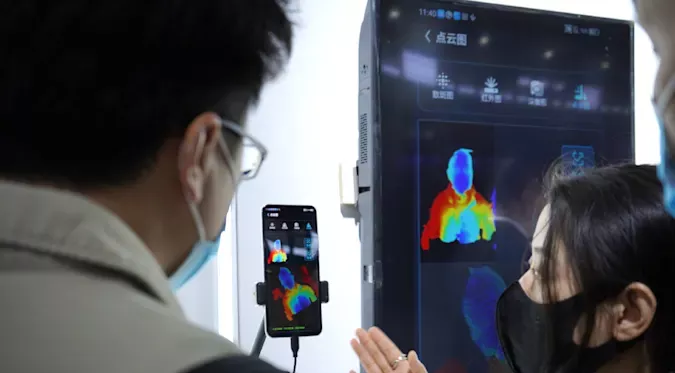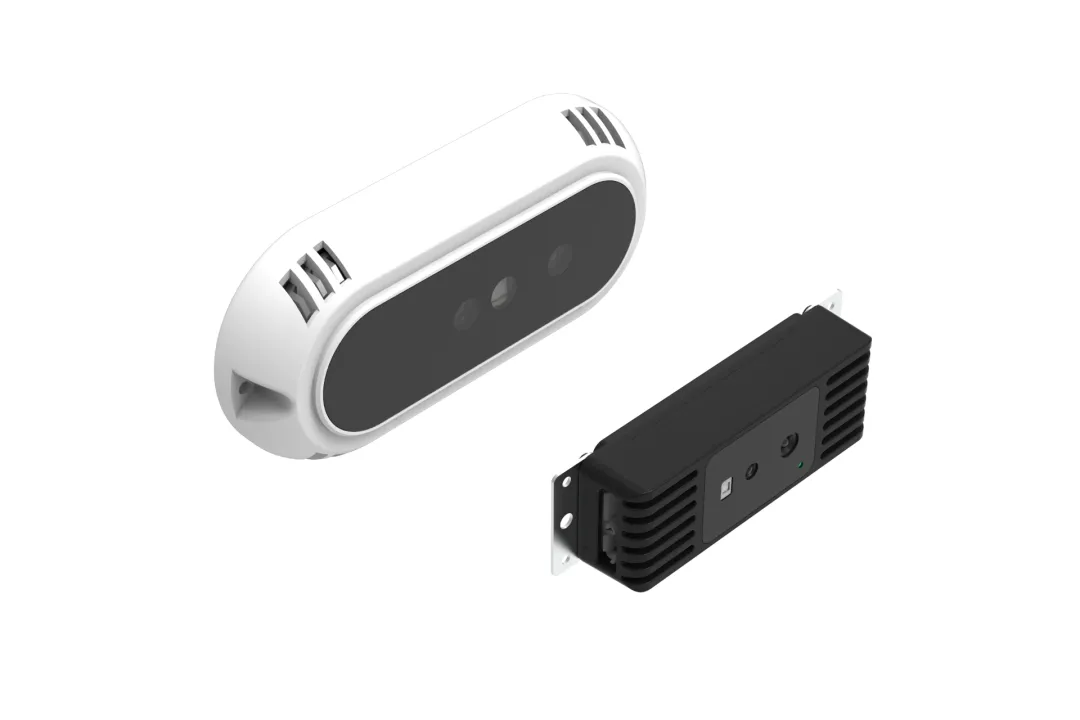News center
Deptrum Tech reignites 3D sensing market growth
The original article is published on the official website of Yole Développement, republished with permission.
Original title: Under-display solution by Deptrum Tech to reignite 3D sensing market growth - An interview by Yole Développement

(Deptrum shows the under-display 3D sensing solution)
Introduction
$15.0B is Yole Développement’s new estimate for the 3D sensing market in 2026, with a substantial compound annual growth rate of 14.5%. 18 months ago, we explained the next growth surge would be on the smartphones’ rear side. Since then, our projections for the 3D sensing market have reduced, as thoroughly explained in our newest report “3D Imaging & Sensing 2021”. One reason is linked to the US Huawei ban. The company was at the forefront of the rear 3D sensing solution adoption. This enforced limitation has slowed down the 3D sensing market overall. Another reason is linked to the Android camp’s choices. Many have put their 3D sensing solutions on hold as the added benefit and associated use cases have not appeared too convincing compared to the added cost. So far the mobile and consumer market has been mainly driven by Apple, and its newer direct Time of Flight (d-ToF) “Lidar” approach.
The 3D sensing market is looking for its second wind. Newer, cheaper, solutions for indirect Time of Flight (i-ToF) and under-display 3D sensing capabilities will likely be enablers for a return to market growth by 2023. Shenzhen Guangjian Technology Co.,Ltd. also known as Deptrum Tech., just announced an under-display 3D sensing solution. Yole’s Richard Liu has had the chance to discuss the solution with its CEO, Dr. Li Zhu. In this interview, Dr Zhu kindly shares more about his company, its products, strategy and prospects on 3D sensing.
YD:Could you introduce yourself and Deptrum Tech to our readers?
LZ:My name is Li Zhu, founder and CEO of Deptrum Tech. Before founding Deptrum Tech, I worked in Silicon Valley to push 3D sensing’s debut in consumer products. I received my Ph.D degree from UC Berkeley in nano-optoelectronics.
Deptrum Tech provides 3D sensing products. Our nanophotonic technology enables laser projectors in 3D cameras where VCSEL arrays are not a must. This alternative approach also enabled the under-display 3D camera solution for smartphones, which solves the conflict between the display notch required by 3D cameras and the full screen display design requirement. We are also leading in face payment and robotics applications.
YD:Could you please introduce Deptrum Tech’s structured light (SL) technology in detail and what’s the advantage compared to the other technologies?
LZ:Our SL camera consists of a laser dot projector to create tens of thousands of infrared spots on objects, and an infrared camera to capture the spots. The conventional approach of the projector is to use a VCSEL array with a few hundred emitters and a diffractive optical element (DOE) to repeat the emitter pattern in the projected dot pattern. Instead of using diffraction, Deptrum Tech uses a single edge emitting laser (EEL) with a beam-splitting chip called a wave-front processor. The wave-front processor is a silicon photonic chip with a dielectric metastructure on the chip surface. It can add an arbitrary optical phase to the incidence plane wave, thus splitting the light into the designed pattern. It solves the laser safety hazard risk and temperature dependency by eliminating the optical diffraction in the system. It also takes advantage of the high efficiency and thermal conductivity of the EEL, resulting in more than 50% higher power efficiency.
YD:Using SL for face unlock delivers a great user experience. This is why Apple continues to use it in the iPhone line-up. However, it necessitates a notch on top of the screen and involves high costs, which are two sore points mentioned by the Android camp. How does Deptrum Tech consider those two issues?
LZ:The full screen design concept is dominating flagship Android phones. On the other hand, the SL camera requires separation greater than 20mm between the projector and IR camera, because of its triangulation operation principle. A wide notch is necessary on the front side unless you hide the cameras behind the screen. Currently, the OLED screen can achieve approaching 30% optical transmissivity for infrared light. Thus, the SL camera needs to deal with more than 90% optical loss in the path. In addition, the translucent region on the display requires a unique OLED design. The translucent aperture needs to be as small as possible. Deptrum Tech’s solution nearly doubles the power conversion efficiency. VCSELs suffer from the thermal roll-over effect, which makes the peak emitting power limited by its thermal conductance. EELs have superior thermal properties, thus the peak power can be significantly higher. Therefore, Deptrum Tech’s SL camera can perform very well under 100k lux solar ambient light. This SL camera is ready for mass production and has been used in many Internet-of-Things (IoT) applications. To have this under-display solution widely used in smartphones, the integration of the SL camera with the OLED display is being verified to make sure the display has equivalent performance and reliability as the conventional OLED display.

(Depth color rendering image of human face by Deptrum under-screen sensor)
YD
SL is used in many other applications such as facial recognition payment terminals and access control in high security areas. Could you please expand on the fields you are targeting besides mobile?
An SL camera has good accuracy in the near distance. Therefore, it is ideal for recognition applications. Millions of face payment devices have been deployed in China. The payment experiences are significantly improved in grocery stores, vending machines, dining halls, hospitals and pharmacies and public transportation. This payment experience is overtaking QR codes, rapidly penetrating into all aspects of daily life in China.
SL also has enough accuracy for human 3D modeling. E-commerce companies are working on using 3D face models to help customers find the right accessary products, such as eye glasses, earrings and necklaces. With a 3D foot model, one can find the best-matched shoe sizes online, or even through 3D printing.
LZ
YD:China has achieved a good development in face payment. However, the use of face payment is declining rapidly due to the use of masks in 2020 and people's security concerns about face payment. How will Deptrum Tech face this challenge and build this business?
LZ:Face recognition payment is a very convenient method. It frees the users from the requirement of any medium. The technical challenge is the security of the payment and user privacy. A 3D camera is necessary for anti-spoofing. The Bank Card Test Center (BCTC) of China has adopted 3D cameras as a standard requirement for any face payment. Currently, Deptrum Tech has integrated the anti-spoofing capability and data encryption inside the 3D camera module. It ensures payment level recognition accuracy while only sending out encrypted and vectorized data to the payment platform. The user’s 3D face data is thus securely protected. In short, technology is available to eliminate the security concern. And we encourage other face payment solution providers to incorporate such security standard in their services.
With improving the 3D camera accuracy and the face recognition model, the recognition with face mask is a solved problem. People can have the same smooth payment experience with or without face mask.
YD:Apple released LiDAR in its iPad and iPhone Pro in 2020. This uses dToF technology, which is making the market consider ToF technology again. How do you see the future in terms of 3D sensing technology choices?
LZ:SL and ToF are two complementary 3D sensing technologies. SL has ideal accuracy in the near distance, typically within one meter, whereas ToF has better accuracy in the far distance. Therefore, SL cameras are widely used in recognition and 3D modeling applications, while ToF is preferred in the applications requiring interaction with open space.
Two ToF technologies are frequently mentioned: i-ToF and d-ToF. i-ToF is a relatively more mature technology. The advantage is its higher resolution, lower cost and wide availability. However, the power consumption is high for distances greater than five meters, compared with d-ToF cameras.
We believe that each of SL, i-ToF and d-ToF technologies can find applications because of their advantages and constraints. Structured light covers near distance applications. i-ToF is good enough for most applications within five meters. d-ToF is superior for farther distances.
Currently, only Apple can get volume supply of the Single Photon Avalanche Diode (SPAD) array required in d-ToF cameras. d-ToF is still more or less in the R&D phase for other players in the market. Because of the supply constraint, efforts are being made to improve i-ToF performance to cover farther distances. Deptrum Tech’s m-ToF technology can achieve nearly ten meter ranges by adding temporal and spatial modulation to the projected light field. It fits the gap in Robotics and AR applications where 3D sensing for both very close and far distance is necessary.
YD:Based on your core technologies, what hardware products have Deptrum Tech developed?
LZ:We have developed two series of products. The Aurora series includes SL cameras with different computing capability within the camera. They are used in smartphones, face payment systems and industrial metrologies. The Stellar series includes ToF cameras. They have been widely used in robotics applications.

(Aurora series SL camera by Deptrum)

(Stellar series ToF camera by Deptrum)
YD:You are going to be a speaker of the 3D Sensing for Consumer Forum 2021. What topic and insights are you going to share with the audience? (More information about 3D Sensing for Consumer Forum 2021: https://www.i-micronews.com/event/3d-sensing-for-consumer-forum-2021/)
LZ:In this forum, I will share our vision of machine vision in IoT applications and how 3D sensing redefines those applications to make it powerful, efficient and secure.
YD:Would you like to add some final words for our readers?
LZ:We are witnessing a revolution in capturing images. Photos are no longer limited to plain paper or screens. They are 3D now, the same as the dimensions of the real world. Artificial intelligence is smarter and more compact with 3D data. Thus, complex functions are achieved on IoT devices with very limited computing and power. AI will be significantly more powerful but efficient and enough secure, to help us build a better and more beautiful life.
